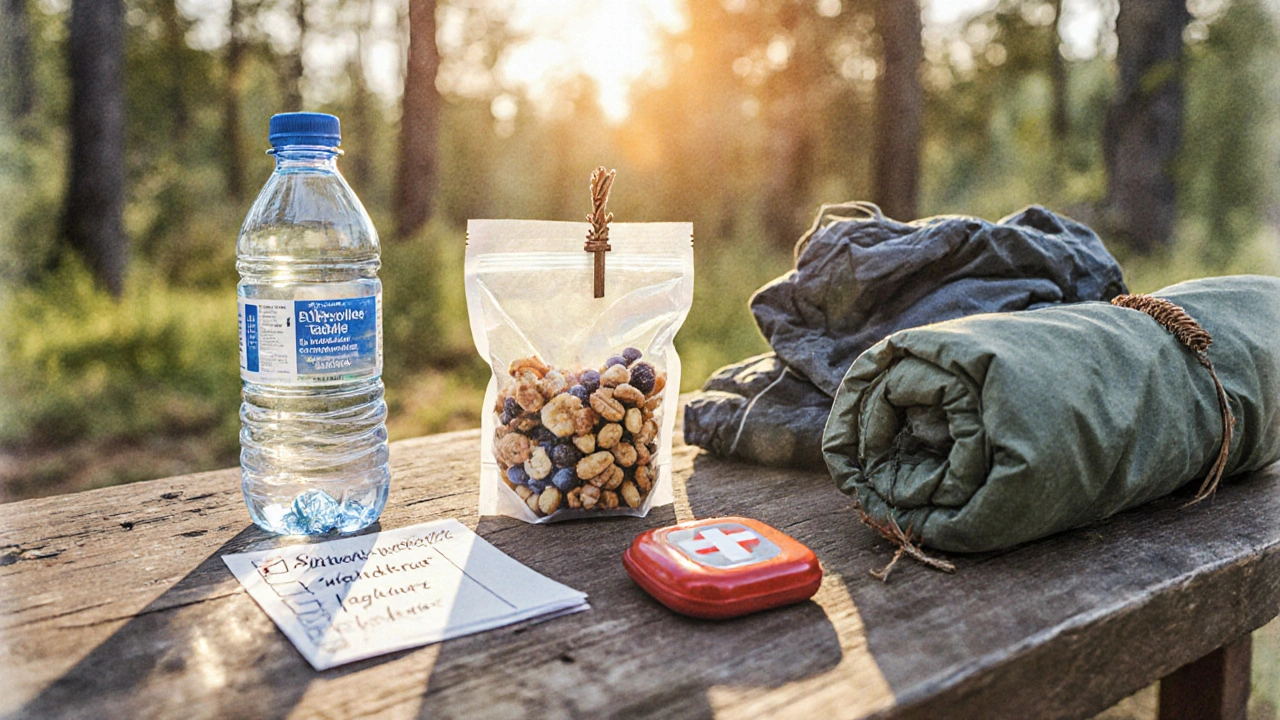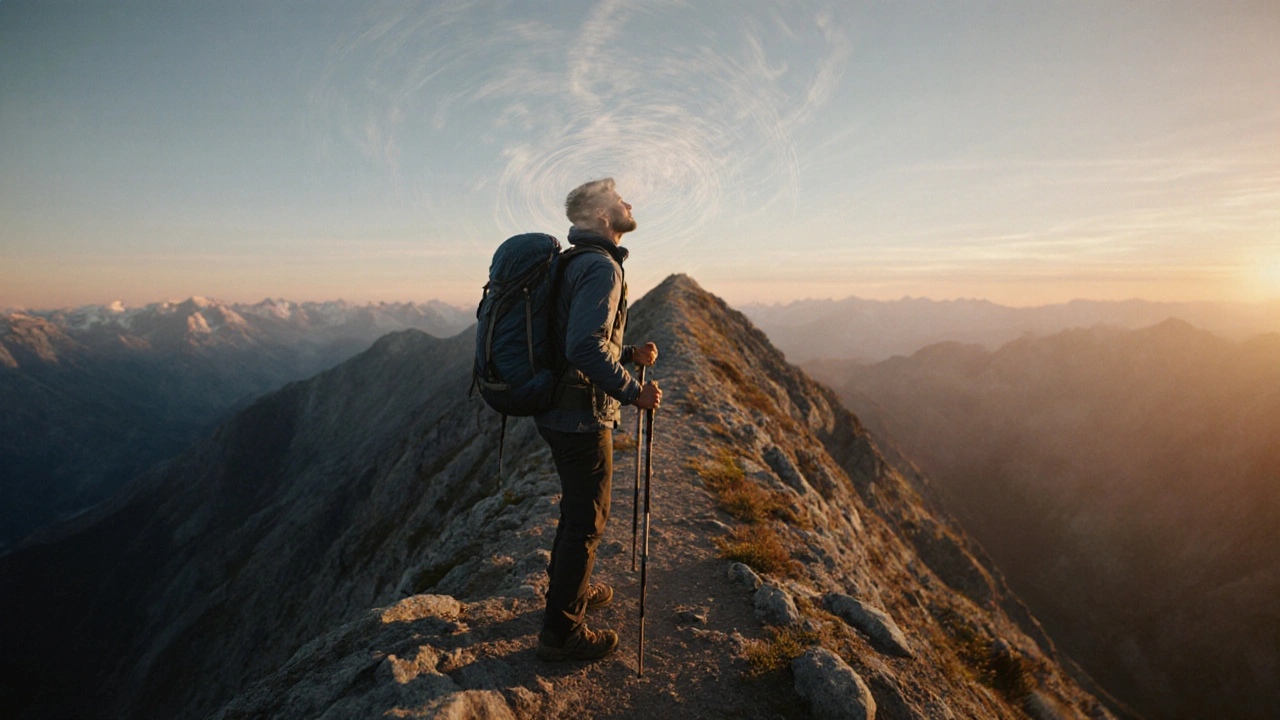Dizziness Remedy Assistant
Choose your hiking conditions
Answer a few quick questions to get personalized remedy recommendations
Recommended Remedy
Best for your hiking conditions and symptoms
Onset time:
Duration:
Dose instructions:
Potential side effects:
Benefits:
Key Takeaways
- Identify the main triggers of dizziness and motion sickness while hiking.
- Apply preventative habits like proper hydration, pacing, and diet before you start.
- Use quick‑relief techniques such as acupressure, breathing exercises, or over‑the‑counter meds when symptoms hit.
- Choose between natural remedies (ginger, tea, peppermint) and proven medications (meclizine, dimenhydrinate) with a clear comparison.
- Carry a personalized checklist to keep your trail experience steady and enjoyable.
Ever felt the world spin a bit too fast while climbing a ridge or walking through a forest? That unsettling swirl is more common than you think, and it can turn a beautiful hike into a miserable trek. Below you’ll find a step‑by‑step guide that turns the vague fear of feeling woozy into concrete actions you can take before, during, and after a hike.
Understanding Dizziness and Motion Sickness on the Trail
Dizziness is a sensation of light‑headedness, unsteadiness, or feeling that the surroundings are moving. While many people link dizziness to inner‑ear problems, on a hike it can also stem from dehydration, low blood sugar, or rapid altitude changes. Motion sickness occurs when your brain receives conflicting signals about motion from the eyes, inner ear, and muscles. On steep, winding paths, those mismatched signals become especially pronounced.
Common Triggers While Hiking
Knowing what usually sets off the spin helps you dodge it. The most frequent culprits include:
- Altitude gain: Even a modest climb to 2,500m (8,200ft) can thin the air enough to induce vertigo.
- Uneven terrain: Zig‑zag trails force your vestibular system to constantly recalibrate.
- Dehydration: Losing just 2% of body water shrinks blood volume, lowering blood pressure and triggering light‑headedness.
- Low blood sugar: Skipping breakfast or running out of snack fuel can cause the brain to “short‑circuit.”
- Strong scents or heat: Aromas from wildflowers, campfires, or high temperatures can overstimulate the inner ear.

Pre‑Hike Prevention Strategies
Preventive habits are the most reliable defense. Treat them like a pre‑flight checklist:
- Hydrate smartly: Aim for 500ml of water two hours before you start, then sip a cup every 30minutes. Add a pinch of salt or an electrolyte tablet to keep sodium levels steady.
- Eat a balanced snack: Combine complex carbs (oats, whole‑grain bars) with a bit of protein (nuts, jerky) 30-45minutes before you hike.
- Acclimatize: If you’re heading above 1,500m, spend a night at a lower elevation to give your body time to adjust.
- Practice paced breathing: Inhale for four counts, hold for two, exhale for six. This slows heart rate and stabilizes blood pressure.
- Dress in layers: Overheating can dilate blood vessels, dropping blood pressure and sparking dizziness.
Immediate Relief Techniques On the Move
If you start to feel light‑headed mid‑trail, don’t panic. Try one or more of these proven tricks:
- Find a stable spot: Sit down, plant your feet flat, and keep your head upright.
- Cold compress: A wet bandana over your forehead or neck drops core temperature fast.
- Acupressure: Press the P6 (Neiguan) point-the inner wrist, three finger‑widths below the base of the palm. Hold for 2‑3minutes; many hikers swear by the calming effect.
- Controlled breathing: Switch to the 4‑7‑8 pattern-inhale 4, hold 7, exhale 8-to quickly raise oxygen levels.
- Ginger chew: Chewing a small piece of fresh ginger or sipping ginger tea can settle the stomach within 10minutes.
Medication vs. Natural Remedies - Quick Comparison
| Remedy | Type | Onset | Duration | Pros | Cons |
|---|---|---|---|---|---|
| Meclizine (Antivert) | Medication | 30‑60min | 24h | Strongly reduces motion sickness; single dose | Drowsiness, not ideal for steep climbs |
| Dimenhydrinate (Dramamine) | Medication | 15‑30min | 4‑6h | Widely available; effective for short hikes | Can cause dry mouth, dizziness in high doses |
| Ginger root (fresh or capsules) | Natural | 10‑15min | 1‑2h | Gentle, no major side effects, good for stomach upset | Less potent for severe motion sickness |
| Peppermint oil (aromatherapy) | Natural | 5‑10min | 30‑45min | Refreshing, also reduces nausea | Strong scent may trigger headaches for some |
| Acupressure wristband | Device | Immediate | While worn | Non‑invasive, reusable | Effect varies person‑to‑person |
When choosing a remedy, match the severity of your symptoms with the onset speed you need. For a long, multi‑day trek, a low‑dose medication taken the night before can keep you steady, while a quick ginger chew works fine for a short scramble.

Build Your Personal Dizziness‑Management Checklist
Having a ready‑to‑go list reduces decision fatigue mid‑trek. Use the template below and customize it based on your experience and the terrain you plan.
| Item | What to Pack | When to Use | Notes |
|---|---|---|---|
| Hydration | Water bottle, electrolyte tablets | Every hour | Mix one tablet per 500ml |
| Snack | Trail‑mix with nuts & dried fruit | Every 2hours | Keep a small portion in each pocket |
| Medication | Meclizine 25mg tablet (or chosen alternative) | 30min before steep sections | Carry a spare in a waterproof bag |
| Natural remedy | Ginger chews or tea bags | First sign of nausea | Can be combined with medication if needed |
| Acupressure band | Wristband with P6 pressure point | Whenever you feel off‑balance | Adjust pressure for comfort |
| Cold compress | Small microfiber towel | Sudden dizziness spike | Wet with water from bottle |
Mark items you’ve tried and note the results. Over time you’ll see a clear pattern of what works best for you, turning the checklist into a personal protocol.
Frequently Asked Questions
Can altitude alone cause dizziness on a hike?
Yes. As altitude rises, oxygen levels drop, which can lower blood pressure and affect the inner ear, leading to altitude‑related vertigo. Acclimatizing and staying hydrated are key preventive steps.
Is it safe to combine ginger with over‑the‑counter motion‑sickness meds?
Generally, yes. Ginger works through a different pathway (stomach soothing) and doesn’t amplify the drowsiness caused by antihistamines. However, start with a small dose to see how your body reacts.
How long before a hike should I take meclizine?
Take it about 30minutes before you start moving on steep or winding sections. Its effects peak around an hour and can last up to a full day, so plan your dosing accordingly.
Why does sitting down sometimes make the dizziness worse?
If your blood pressure drops quickly when you sit, blood may pool in the legs, reducing flow to the brain. To avoid this, sit slowly, cross your legs, and press your feet firmly on the ground while you recover.
What’s the best way to test an anti‑nausea remedy before a long hike?
Do a “trial run” on a short local walk that mimics the terrain and elevation you expect. Take the remedy at the same time you’d use it on the real hike and monitor how you feel for at least two hours.
Next Steps and Troubleshooting
If you still feel unsteady after trying the above, consider these additional actions:
- Check for underlying health issues: Iron deficiency, low blood pressure, or vestibular disorders can amplify trail‑induced dizziness.
- Consult a doctor before long expeditions: A professional can prescribe a tailored regimen, especially if you travel to altitudes above 3,000m.
- Re‑evaluate your gear: Heavy backpacks can shift your center of gravity, stressing the vestibular system.
Remember, the goal isn’t to eliminate every wobble-it’s to keep it manageable so you can enjoy the scenery, breathe fresh air, and keep moving forward.
hiking dizziness doesn’t have to ruin your adventure. With the right prep, quick‑fix tactics, and a personalized checklist, you’ll stay steady on the path and make the most of every summit.



Comments
Life on the trail is a metaphor for the endless ssearch for balance, yet most hikers forget that the real climb is inside their own head. You can pre‑hydrate, pack ginger, and still feel like the world is spinnning, which is kinda why the article feels like it’s preaching to the choir while missing the deeper why.
While the guide offers a commendable array of preventative measures, I would emphasize the importance of electrolyte balance in conjunction with fluid intake. Sodium‑chloride solutions facilitate plasma volume expansion, thereby mitigating orthostatic hypotension, a frequent culprit of vestibular disturbance. In practice, a 250‑ml serving containing 300 mg of sodium consumed at 30‑minute intervals during ascent yields optimal results.
Listen up, fellow trail‑blazers, because the truth about motion sickness on a mountain is far more dramatic than any bland checklist could ever capture! First, altitude itself is a sneaky tyrant, stripping oxygen from your blood and causing that dreaded spin that makes you feel like you’re on a carnival ride while clutching a rock. Second, dehydration isn’t just a mild inconvenience – it’s a full‑blown betrayal of your body’s equilibrium, turning a gentle incline into an unforgiving rollercoaster. Third, the infamous “low‑blood‑sugar” dip is a silent assassin, striking when you skip that crucial snack, leaving you weak, wobbly, and questioning every life choice you’ve ever made.
Now, let’s talk remedies: ginger, the ancient warrior of nausea, works faster than a cheetah on a caffeine binge, calming the stomach within ten minutes and keeping your mind clear for those panoramic vistas. 🌿💪 Then there’s the acupressure wristband, a tiny device that presses the P6 point with the relentless dedication of a drill sergeant, offering immediate relief that lasts as long as you wear it. And for those daring enough to venture into high‑altitude territory, a modest dose of Meclizine is not just a pill – it’s a shield, a fortress against the relentless spin, lasting a full twenty‑four hours if you time it right.
Don’t forget the power of breathing techniques; the 4‑7‑8 method can reset your heart rate faster than a reboot, and the cold compress is a secret weapon that drops core temperature, instantly stalling the dizziness. Finally, remember that preparation is your greatest ally: hydrate with electrolytes, snack on complex carbs, acclimate whenever possible, and always pack a spare ginger chew. Follow this protocol, and the mountain will bow to you, not the other way around. 🌄🚀
Wow, because we totally needed another "hydrate or die" reminder while already sweating through the guide.
Great points above! Just remember to keep your pace steady – a slow, consistent stride helps your vestibular system stay in sync. If you start feeling light‑headed, pause, sip a little water with a pinch of salt, and do a few deep breaths. You’ll recover quickly and stay on track for the summit.
Yo, i think the article missest the fact that many hikers dont even kno w about the wristbnd acupressur. its like a secret weapon that could saved many from throwing up on the trail.
I love how the guide blends cultural practices like ginger tea with modern meds – it reminds me of the way traditional Ayurvedic wisdom can coexist with contemporary science, making the whole experience richer.
Sure, just pop a pill and the government won’t track your dizziness.
That short‑answer vibe is actually motivating! When you feel that sudden spin, think of it as a cue to pause, re‑hydrate, and refocus. By treating each symptom as a signal rather than a setback, you keep moving forward with confidence.
Honestly, the article feels like a checklist written by someone who never actually hiked. It’s all “drink water, chew ginger,” but where’s the real talk about how many times you’ve actually vomited on a ridge?
While it’s commendable to provide practical tips, the piece skirts the moral responsibility of hikers to respect their own bodies and the environment by over‑relying on pharmaceutical shortcuts. True stewardship means mastering natural resilience before reaching for pills.
One could argue that the dance between altitude and equilibrium mirrors the eternal human quest for balance – a reminder that every summit is both external and internal.
Ever notice how the biggest pharma companies push meclizine like it’s a miracle cure while quietly funding research that downplays the long‑term effects of antihistamines? It’s a classic example of how corporations manipulate health narratives to sell more pills.
Nice guide! :) Keep in mind that a supportive community can share tips and even lend a spare ginger chew when someone’s running low. Sharing knowledge makes the trail safer for everyone.
i think the article overhypes ginger and underestimates the power of a good old‑fashioned headache pill, lol.
I totally get how frustrating dizziness can be. Taking a moment to breathe, sip water, and maybe chew a little ginger can make a big difference. You’re not alone in this.
This is exactly why I love mixing science with culture – ginger, breathing, and good gear all work together to keep us moving forward. Let’s keep sharing these gems!
Stop whining and just prep your pack like a pro. Hydrate, snack, and if you feel off, slam that ginger and keep climbing. No excuses.
It is imperative to acknowledge that the prophylactic administration of Meclizine, when timed appropriately, constitutes a highly efficacious strategy for mitigating vestibular disturbances during protracted ascents. Accordingly, the recommendation to ingest the dose thirty minutes prior to the commencement of strenuous activity is both prudent and scientifically substantiated.
Great tips! Keep it up and enjoy the trails.